Preventive and Diagnostic
Comprehensive exams
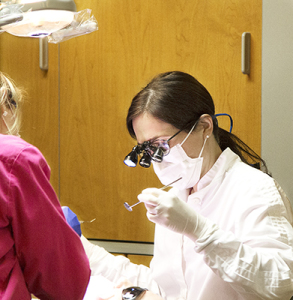 We do a complete exam of your teeth, gums, and soft tissue (intraoral and extraoral). We utilize necessary X-rays to help us carefully check each tooth and the surrounding bone and gum tissue. We will discuss options for needed treatment and come up with a solution that is right for you. We utilize a handheld device called Oral ID, which uses fluorescence technology to help detect oral cancer or precancerous lesions. We scan over the soft tissue in the mouth with the blue light and are able to detect abnormalities that may not be visible with just a visual exam.
We do a complete exam of your teeth, gums, and soft tissue (intraoral and extraoral). We utilize necessary X-rays to help us carefully check each tooth and the surrounding bone and gum tissue. We will discuss options for needed treatment and come up with a solution that is right for you. We utilize a handheld device called Oral ID, which uses fluorescence technology to help detect oral cancer or precancerous lesions. We scan over the soft tissue in the mouth with the blue light and are able to detect abnormalities that may not be visible with just a visual exam.
Digital x-rays
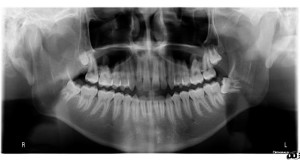 We utilize digital X-rays in our office. Instead of capturing images in the mouth on X-ray film, we use a sensor that is connected to our computer by a cable. The images of the teeth and bone can be viewed on the monitor, where we can enlarge and sharpen the images. This helps us in making an accurate diagnosis. Radiation exposure is reduced by 80-90% when using a sensor compared to traditional film.
We utilize digital X-rays in our office. Instead of capturing images in the mouth on X-ray film, we use a sensor that is connected to our computer by a cable. The images of the teeth and bone can be viewed on the monitor, where we can enlarge and sharpen the images. This helps us in making an accurate diagnosis. Radiation exposure is reduced by 80-90% when using a sensor compared to traditional film.
Teeth cleanings and check-ups
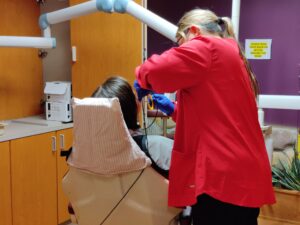 Having healthy gums and bones to support your teeth is essential to overall oral health and systemic health. It is important to regularly brush and floss your teeth to keep food debris and plaque from accumulating on the surfaces and irritating the gums. Soft plaque can harden on the teeth and become tartar, which needs to be scraped away by your dental hygienist or dentist. It is important to have regular check-ups and teeth cleanings to prevent problems or to detect any decay and gum problems when they are small.
Having healthy gums and bones to support your teeth is essential to overall oral health and systemic health. It is important to regularly brush and floss your teeth to keep food debris and plaque from accumulating on the surfaces and irritating the gums. Soft plaque can harden on the teeth and become tartar, which needs to be scraped away by your dental hygienist or dentist. It is important to have regular check-ups and teeth cleanings to prevent problems or to detect any decay and gum problems when they are small.
Sealants and fluoride treatments
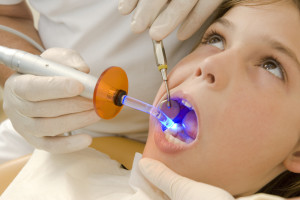 Sealants are a resin protective coating applied to grooved areas on a tooth, like the chewing surfaces of molars. They are effective in keeping plaque and food debris from sitting in the grooves and crevices of the teeth and causing decay. Fluoride treatments, such as gel and varnish, can be applied to the teeth to help strengthen, re-mineralize, and desensitize them.
Sealants are a resin protective coating applied to grooved areas on a tooth, like the chewing surfaces of molars. They are effective in keeping plaque and food debris from sitting in the grooves and crevices of the teeth and causing decay. Fluoride treatments, such as gel and varnish, can be applied to the teeth to help strengthen, re-mineralize, and desensitize them.
Periodontal treatments
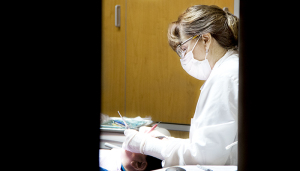 Periodontal scaling and root planing: Heavy plaque and tartar build-up on the teeth can lead to bleeding gums, bone loss, and deep pocketing of the gums around the teeth. In order to help heal the gums and stop bone loss, it is necessary to clean the root surfaces below the level of the gums with ultrasonic and hand instruments. Antimicrobial rinses are sometimes used to flush the pockets out and then prescribed for the patient to rinse with at home.
Periodontal scaling and root planing: Heavy plaque and tartar build-up on the teeth can lead to bleeding gums, bone loss, and deep pocketing of the gums around the teeth. In order to help heal the gums and stop bone loss, it is necessary to clean the root surfaces below the level of the gums with ultrasonic and hand instruments. Antimicrobial rinses are sometimes used to flush the pockets out and then prescribed for the patient to rinse with at home.
Submit your review | |




